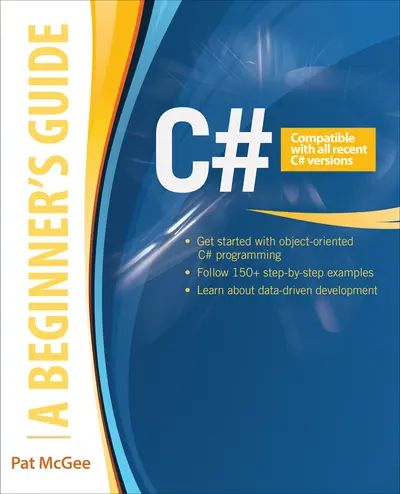My Account Details

ISBN10: 0071835830 | ISBN13: 9780071835831

Step 1 . Download Adobe Digital Editions to your PC or Mac desktop/laptop.
Step 2. Register and authorize your Adobe ID (optional). To access your eBook on multiple devices, first create an Adobe ID at account.adobe.com. Then, open Adobe Digital Editions, go to the Help menu, and select "Authorize Computer" to link your Adobe ID.
Step 3. Open Your eBook. Use Adobe Digital Editions to open the file. If the eBook doesn’t open, contact customer service for assistance.
Publisher's Note: Products purchased from Third Party sellers are not guaranteed by the publisher for quality, authenticity, or access to any online entitlements included with the product. Essential Skills--Made Easy! C#: A Beginner's Guide offers a step-by-step approach to learning object-oriented programming with C# and the .NET Framework while preparing you for data driven-development. More than 150 easy-to-follow examples are included. The book covers Visual Studio for developmentand debugging, collections and advanced C# structures,LINQ and traditional database development, as well as file, XML, and JSON handling. By the end of the book, you'll have the foundation you need to begin developing advanced data-driven applications in any C#-based platform. Designed for Easy Learning Key Skills & Concepts--Chapter-opening lists of specific skills covered in the chapter Try This--Hands-on exercises that show you how to apply your skills Notes--Extra information related to the topic being covered Tips--Helpful reminders or alternate ways of doing things Cautions--Errors and pitfalls to avoid Self Test--End-of-chapter quizzes to reinforce your skills Example code with commentary that describes the programming techniques being illustrated Ready-to-use code at www.mhprofessional.com
Ch 1. Introduction to C# Coding and Debugging
Ch 2. Variables, Constants, Enumerations and Arrays
Ch 3. Numeric Operators and Basic Math Methods
Ch 4. Methods and Scope
Ch 5. Conditional Structures and Loops
Ch 6. String Manipulation
Ch 7. Date and Time Handling
PART II: Object-Oriented Programming
Ch 8. Class and Structs
Ch 9. Inheritance
Ch 10. Generic Types and Collections
PART III: Advanced Structures
Ch 11. Delegates, Anonymous Functions and Events
Ch 12. Interfaces
Ch 13. Attributes
Ch 14. Operator Overloading
PART IV: Data-Driven Development
Ch 15. Database Setup
Ch 16. The Entity Framework
Ch 17. LINQ to Entities - Query Syntax
Ch 18. LINQ to Entities - Method-Based Syntax
Ch 19. Traditional Database Development
Ch 20. Join Queries with LINQ to Entities
Ch 21. File Input Output
Ch 22. XML Handling
Ch 23. JSON Handling
Need support? We're here to help - Get real-world support and resources every step of the way.